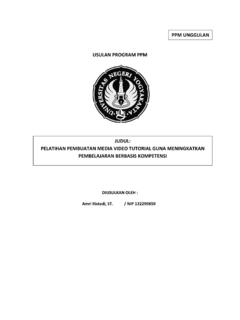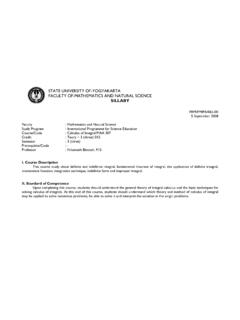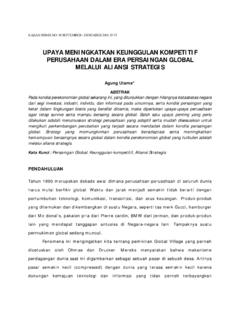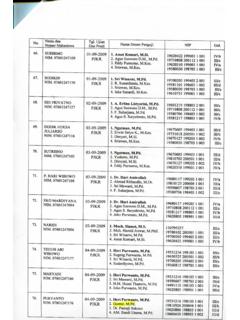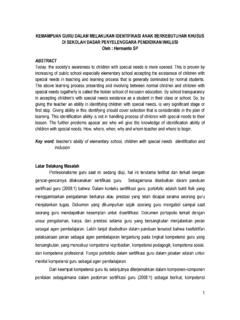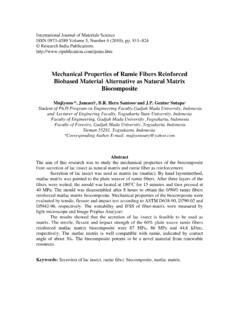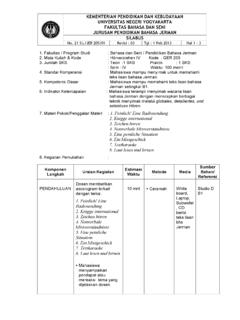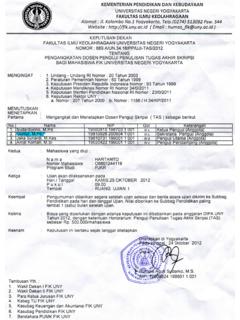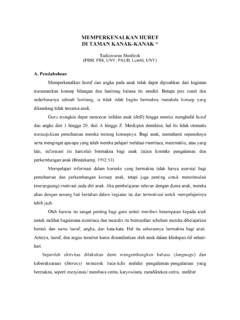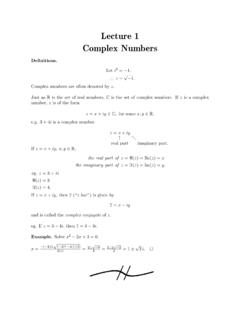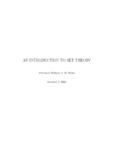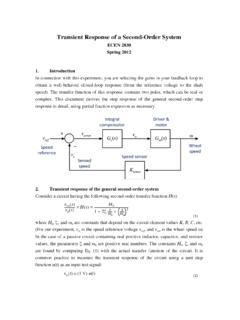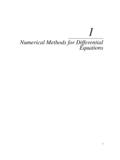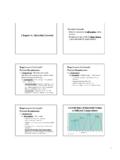Transcription of Lecture 4 Lecture 4 - Feynmans Feynmans thought thought ...
1 Lecture 4 Lecture 4 -- FeynmansFeynmans thought thought experimentsexperiments Things on a very small scale behave like nothing we have direct experience about. Even the experts do not uderstand it the way they would like to We know how large objects will act but things on small scale just do not act that waynot act that way Act in sort of abstract or imaginative fashion. We can not connect it with our direct experience Examines phenomenon which is impossible to explain in any classical way and has in it heart of QUANTUM MECHANICS Contains the only mystery Cannot make the mystery go away by explaining how it worksThought experiment with BulletsThought experiment with BulletsP12= P1 + P2gunbackstopP1 Parmor platedetector12 Machine gun sprays bulletsOver a large angular spreadA wall made of armor platewith two holes in it to allowthe bullets to pass throughA backstop made of wood &a detector which collects bullets and can be moved inx directionWhat is the probability that that a bullet which passes thru the holes in the wall will arrive at the
2 Backstop at a distance x from the center?P2 Bullet ExperimentBullet experiment Why speak of probability? Probability chance that the bullet will arrive at the detector Can measure by counting the number which arrive within certain time The ratio of this number to the total number of bullets detected is called probabilityprobability Bullets arrive in lumps one whole bullet Probability as P12because bullets may have come from either hole 1 or hole 2. P1probability with only hole 1 open P2probability with only hole 2 open Probabilities just ADDT hought Experiments with Water WavesThought Experiments with Water WavesI1I I1 + I2 Shallow trough of watersmall object labeled wavesource jiggled up and downA detector gadget which measuresThe intensity of wave motionScale square of the height of wave motionI2 Right of the sourcea wall with two holesBeyond that a secondwall an absorberso that no reflection Intensity can have any value No lumpiness in the wave intensity We measure the wave intensity for various values of x and we get I12 thought Experiments with Water Waves thought Experiments with Water Waves ( )( )
3 Original wave is diffracted at the two holes New circular waves spread out interfering and giving us the pattern I12 I1is the intensity of the wave with hole 1 open hole 2 closed I2with hole 2 open and hole 1 closed The Intensity I12is certainly not the sum of I1 & I2. We say there is interference of two waves At some places where the waves are in phase & the wave peaks add together to give a large amplitudeThought Experiments with Water Waves thought Experiments with Water Waves ( )( ) There is constructive inteference correspond to large values of I12 At places where the two waves arrive with a phase difference of the waves will interfere destructively --low values of I12 Quantitative relationship between I1 I2 & I12 The instantaneous height of the water wave = h1ei twhere the amplitude h1 in general is a complex number.
4 Similarly for hole 2 it is h2ei t The mathematics of the whole process becomes very simple If hole 1 is open then intensity I1is given by = |h1|2 If hole 2 is open then intensity I2is given by = |h2|2 If both the holes are open the wave heights add to give the height (h1 + h)ei t thought Experiments with Water Waves thought Experiments with Water Waves ( )( ) If both the holes are open the wave heights add to give the height (h1 + h2)ei t I12= |h1+ h2|2= |h1|2 + |h2|2 + 2 |h1| |h2|cos Where is the phase difference between h1 & h2In terms of intensities we have I12= I1 + I2 + 2 I1 I2 cos If amplitudes add and intensity can have any valueExperiment with ElectronsExperiment with ElectronsSmall wall with two holesP1wallMovable12backstopP12 P1 + P2P1 = | 1|2P2 Movabledetector2 Electron gun ofTungsten wireGeiger counter or anElectron multiplierP2 = | 2|2P12= | 1 + 2|2 Originally when feynman s book came out probably he was unaware and wrote We should say right away that you should not try to set this experiment .
5 The experiment wouldHave to be impossibly small We hear clicks from the detector all clicks same. There are no half clicks Clicks come erratically statistical process As the detector is moved around the rate at which the clicks appear is faster or slower but the size of each click is same If we put two separate detectors at the backstop one or the other would clickExperiment with Electrons ( ) experiment with Electrons ( ) If we put two separate detectors at the backstop one or the other would click Electrons arrive in identical lumps What is the relative probability that an electron lump will arrive at a distance of x from the center This is the interesting curve P12 The Interference of electrons (understanding The Interference of electrons (understanding their behaviour)their behaviour) Since they come in lumps electron has either come thru hole 1 or hole 2.
6 Assuming the above electrons can be divided into two classes (1) Those that come thru hole 1 (2) Those that come thru hole 2 . With both holes open, the effect should be sum of the effects of one hole open Make measurements with hole 1 and 2 open and we get P1& P2 The result P12with both holes open is clearly not the sum of P1& P2 In analogy with water waves we say there is interference. How is it possible? Electrons either go thru hole 1 or hole 2 is not correct. They split in But no they arrived in lump. They went thru complicated path hole 1 and then went around and then went thru hole 2 There are some points that had very few electrons when both holes are open but which receive many electrons when we close one hole.
7 Closing one hole increased the number passing thru other. On the otherhand at the centre of the pattern P12is more than twice as large P1 + It is as if closing one hole decreased the probability thru other also Very Yet the mathematics is very For P12 is quite similar to I12. What is going on at the backstop can be described by two complex numbers 1& 2 The electrons arrive in lumps like particles and the probability of arrival of these lumps is distributed like the distribution of intensity of a wave. It is in this sense that electron behaves like particle as well as waves. The Interference of electrons (understanding their The Interference of electrons (understanding their behaviour)behaviour)behaves like particle as well as waves.
8 For classical waves, intensity was defined as the mean over time of the square of the wave amplitude and used complex numbers as mathematical trick to simplify analysis. Quantum mechanics also we must use complex numbers. There are a large number of subtleties Finally since the number of electrons that arrive at a point is not the sum of electrons that go thru 1 and 2 hence the proposition that electrons go thru either hole 1 or hole 2 is the electronsWatching the electronsP1 wall12backstopP =P +P P1 = | 1|2 Electron thru hole 1 Keep track of whether we sawthe flash near hole 1 or hole 2We do find that P2 2P12 =P1 +P2 Electron gun ofTungsten wireP2 = | 2|2 Electron thru hole 2 Every time you hear a click you see a flash either near hole 1 Or hole 2.
9 Experimentally then the proposition that electron goes thru either hole 1 or hole 2 is necessarily succeeded in watching theelectrons but we destroyed the interference When we look at electrons, their distribution on the screen is different than we do not look We turn off the light source and P12 becomes identical to P12 ---interference is Turning on the light source disturbed the electrons light gives a jolt to the electronsWatching the electronsWatching the electrons Turn down the brightness Sometimes we hear the click but do not see the flash. Flash is always of the same size. Light is also like electron. Electrons were not seen as photon was not around. Make three columns Column 1 flash near hole 1 Column 2 flash near hole 2 Column 3 clicks heard but no flash.
10 The one where you do not see the flash shows interference Those seen near hole 1 have probability distribution P1 & near hole 2 have distribution P2 Those in column 3 show interference pattern. If the electrons are not seen we observe interference pattern When we see a photon disturbs it and if we don t the photon does not disturb the electronsWatching the electrons Reduce the momentum -- Increase the wavelength Remember two objects can be resolved if the distance between them is of the order of /2. As we increase the wavelength and it becomes greater than the distance between the two holes. We see one big flash but cannot tell thru which hole the electron went. It is at that time the interference pattern appearsHeisenberg s Uncertainty PrincipleHeisenberg s Uncertainty Principle Impossible to arrange light in such a way that one can tell thru which hole the electron passed and still see interference pattern.

